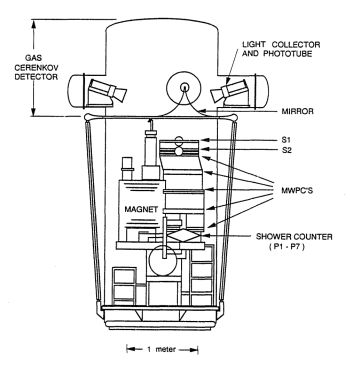Purpose of the flight and payload description
The objective of the balloon flight was to investigate medium-energy antiprotons and positrons in the cosmic rays using a superconducting magnet spectrometer developed by the Physical Science Laboratory in Las Cruces based on a previous apparatus developed by the same scientific group at the NASA's Johnson Space Center.
A basic scheme of the magnet spectrometer and the container gondola in its 1986 flight configuration is shown in the figure at left (click to enlarge). The modifications of the apparatus from previous missions consisted in lowering the Gas Cerenkov threshold (to provide rejection of atmospheric background at lower energies) and a reduction in the shower counter depth to reduce weight.
The spectrometer has three main components: the SUPERCONDUCTING MAGNET, the MULTIWIRE PROPORTIONAL COUNTERS (MWPC) stack and the GAS CHERENKOV COUNTER. The magnet was a scaled-up version of the first superconducting magnet to fly successfully on a balloon by the NASA JSC group back in 1969-1970. The magnet was 61 cm in diameter and produced a magnetic field of ~40 kilogauss at the center of the coil when operating at a current of 120 Amperes. It weighed 150 kg and was maintained at a temperature a few degrees above the absolute zero inside a cryostat cooled by liquid helium. The purpose of the magnet was to deflect the course of heavy particles reaching the detector from outer space, so that the charge and momentum of each particle -its characteristic signature- can be measured.
The MWPC stack, consisted of eight identical 50 x 50 cm2 MWPCs modules with a total separation of 110 cm staggered horizontally so that the top chambers are closer to the magnet face. This increased the effective maximum detectable rigidity of the spectrometer. The MWPCs position measurements were digitized using distributed inductance delay lines coupled to the chamber wires. The chambers were oriented with the anode wires perpendicular to the magnet axis so that most of the bending in the magnetic field occurs along the cathode coordinate axis. Position measurement, in each coordinate axis, was obtained by measuring the time of arrival of the signal at each end of the delay lines.
The gas Cherenkov counter was located above the MWPC stack. The detector was filled with air or sulfur hexafluoride depending on the flight objectives. Its aperture was divided equally by four spherical mirrors, each of which was viewed by a 12.5 cm diameter RCA SA3006E high quantum efficiency "teacup" photomultiplier tube (PM) through a conical mirror that acted as a high transmission lens. The overall length of this detector was 1 meter, with an effective path length of 80 cm.
The instrument and all its components, including electronics and batteries were encased in an insulated gondola 5 meters tall and 2.4 meters in diameter with a total mass of 2100 kg.
Details of the balloon flight
Balloon launched on: 9/26/1986 at 23:49 utc
Launch site: Ainsworth Municipal Airport, Nebraska, US
Balloon launched by: National Scientific Balloon Facility (NSBF)
Balloon manufacturer/size/composition: Zero Pressure Balloon N26-.8/.8/.8/.8T-23.30
Balloon serial number: R23.30-3-104
Flight identification number: 211N
End of flight (L for landing time, W for last contact, otherwise termination time): 9/27/1986 at 17:44 utc
Balloon flight duration (F: time at float only, otherwise total flight time in d:days / h:hours or m:minutes - ): 13 h 40 m
Landing site: 20 miles SE of Rochester, Minnesota, US
Payload weight: 4100 lbs
During the flight 3.2 million cosmic ray trajectories were measured. The combination of lower geomagnetic cutoff of the launch site and longer flight have resulted in a considerable increase in the number of observed anti-protons.
External references
- Antiparticle and Electron Components of Cosmic Rays, and Some Aspects of X-ray Astronomy and Gamma Ray Bursts 21st International Cosmic Ray Conference. Volume 11, p.99
- Balloon prompts calls from curious Rapid City Journal from Rapid City, South Dakota, Sunday, September 28, 1986, Pag. 27
- It's a bird Argus-Leader from Sioux Falls, South Dakota, Sunday, September 28, 1986, Pag. 21
- Measurement of Galactic Cosmic Ray Proton and Helium Spectra During the 1987 Solar Minimum PH.D. Thesis by Eun-suk Seo, Louisiana State University (1991)
- Measurement of Proton and Helium Rigidity Spectra Between 1. 65 and 100 GV/c Using a Magnet Spectrometer 21st International Cosmic Ray Conference. Volume 3, p.5
- Measurement of the Anti-Proton Rigidity Spectrum Between 3 and 10 GV/c Using a Magnet Spectrometer 21st International Cosmic Ray Conference. Volume 3, p.291
- NASA Conducts Balloon Flight The Daily Times from Salisbury, Maryland, October 9, 1986, Pag. 10
- No, It was not a UFO The Sioux City Journal from Sioux City, Iowa, Sunday, September 28, 1986, Pag. 16
- Observation of Cosmic Ray Antiprotons from 2 TO 12 Gev/c 20th International Cosmic Ray Conference Moscow, Volume 2, p.76
- Solar modulation of hydrogen and helium cosmic ray nuclei spectra above 400 MeV/Nucleon, from 1976 to 1993 24th International Cosmic Ray Conference, Italy, 1995
If you consider this website interesting or useful, you can help me to keep it up and running with a small donation to cover the operational costs. Just the equivalent of the price of a cup of coffee helps a lot.


